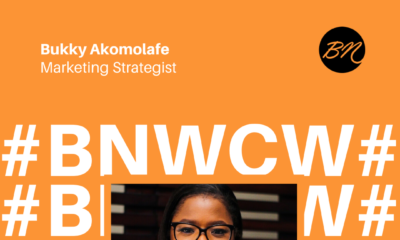Features
Emmanuella Elenbalu: Now That you Have a Good Product, What’s your Marketing Strategy?

You’ve put so much into creating your product and now it has turned out perfect, but how do you get your target market to remember your product when there are millions of the same kind of product? You say your product is ‘unique’, but how do you know if there is a ready market for that product? What about the big players in your industry? How do you get your product competing with theirs? What’s your product marketing strategy? These are a few of the questions you need to ask yourself when searching for the best marketing strategy for your products.
Here is a quick run-through of 4 ways you can develop your marketing strategy:
Understand your target market
There is no better way to know how your target customer would react to your product than to have a deep understanding of who they are and how they think.
This is not you guessing. You can’t afford to build your entire marketing strategy on guesses. Understanding your customer means researching, taking a detailed survey, and interviewing your existing customers to get you to see a common path that would help you detect your future customers. Understanding your customers is deliberate hard work that pays the highest in the long run.
So how do you get started?
First, set up an interview with your existing customer. You can talk to 3-5 customers or even more, this depends on when you get the information you are looking for. While talking to them, take note of similarities like age bracket, location, sex. You can go further by knowing their motivation, interest, fears, and likes. The kind of questions you ask during this section depends on the kind of information you plan to have gathered at the end of the interview. On the other hand, you can send a survey form to customers or better still go all-in with research.
Whatever approach you decide to go with, make sure that your final results are based on valid data.
Know your competitions
This is not the same as being obsessed with your competitions. If you are just starting your business, it’s a good idea to research your competitors to see what works in the market and how customers take the product you plan to market.
If you are already in the market, it’s still a good idea to check up on your competitions once in a while. You’re not a fan of sudden surprises right? Even if you are, it’s nice to follow up with your competition’s activity so you can predict their next game-changer and prepare for it.
Things you should be looking out for while you research your competitors.
- Competitor consumer reviews
If their customers are complaining about a particular problem in their product and they are not giving a response, you can create an improved version with all those issues resolved and promote it strategically among them. They would want to try it out; who doesn’t want something better?
- Competitions social media
It is easy for you to see your competition’s customer care strategy through social media. How is their communication with customers? Are they responsive? Also, you can detect their content strategy, like the kind of post(s) that get higher engagement. This could serve as a map of how you can structure your social media strategy. You don’t have to start from scratch.
- Competitions pricing
This tells you what price they sell their product. It helps you make your price decision so you don’t charge too high (and look like a joke) or too low (and perceived to lack value).
Draft your plan
From the information you gathered from the research of your target market and competitions, you would get details that would help you draft out your marketing plan.
- Social media
You now know where your customers hang out, you know the conversion they are making and who influences them on the social media space. Build your social media marketing plan around these findings.
There is no need to waste resources on LinkedIn if the majority of your potential customers hang out on Twitter. The kind of content you post on your social media channels should be consistent with what interests your target market at that particular time, whether it revolves around your brand, industry, or not.
To help you keep track of these trending topics, make use of Tweet Deck, Google Alert, and a bunch of other social listening tools. You can also take advantage of social media campaigns and hashtags when marketing a new product.
Influencer marketing which is gaining more grounds than celebrity marketing involves you getting your product endorsed by the people who influence your target market on the social media space.
If you can’t get them to endorse your product then you can try strike conversions with these Influencers, letting your customers see that you and they share a common interest. This is a great way to build relationships that promote products.
One more thing, remember social media marketing is no longer a one-way communication where you put up advertisements and don’t expect a response. It’s now more about interacting and engaging directly with your audience all in a bid to gain trust. Once you gain that trust getting them to buy from you would no longer be a hassle.
- Affiliate Marketing
Affiliate marketing is a great way to increase your product reach. It involves getting people to promote your product on their blogs or social media channels and paying them for each sale they make for you. In this type of marketing, you have better control of your advertising money.
If you blog, look into optimizing your page for search engines so your product and brand are easily found when searches are made with keywords relating to your product.
Craft a compelling story
Shoppers convert to buyers because a certain product resonates better than its competition, and this usually because the marketer builds a better story, not because the price is lower or the product is better.
People have an intrinsic desire to belong so when you create a story around your product, you get them to buy your product not just because it has a better feature but because they want to be part of the story you are telling.
Don’t tell us what you sell, tell us why you sell it. Tell us that extra that makes us care. Don’t tell us you sell cupcakes, we are already having a tough time choosing from the hundreds we see every day. Instead, tell us your why. You can say your cupcake is baked solely to be the perfect companion for every occasion, whether we are celebrating a birthday, having a sleepover, or getting over a breakup. That’s a story. When people buy it, they don’t buy it because your cupcake is better than the alternatives but because they see it as a companion. They bought the story. A good story makes it easier for people to remember you.
With a deep understanding of your target market, familiarity with what works in your market and how, a concrete plan, and a compelling story, your product marketing strategy is set for the moon.






















